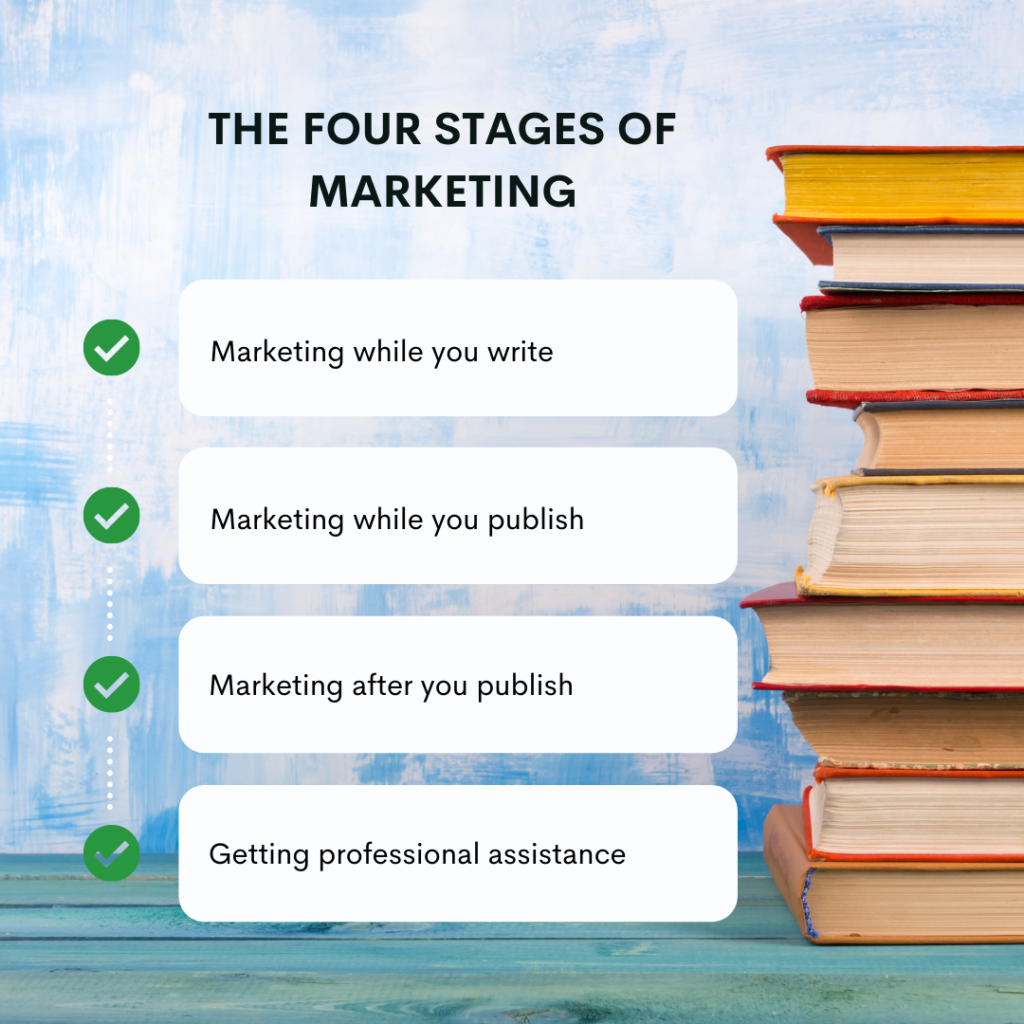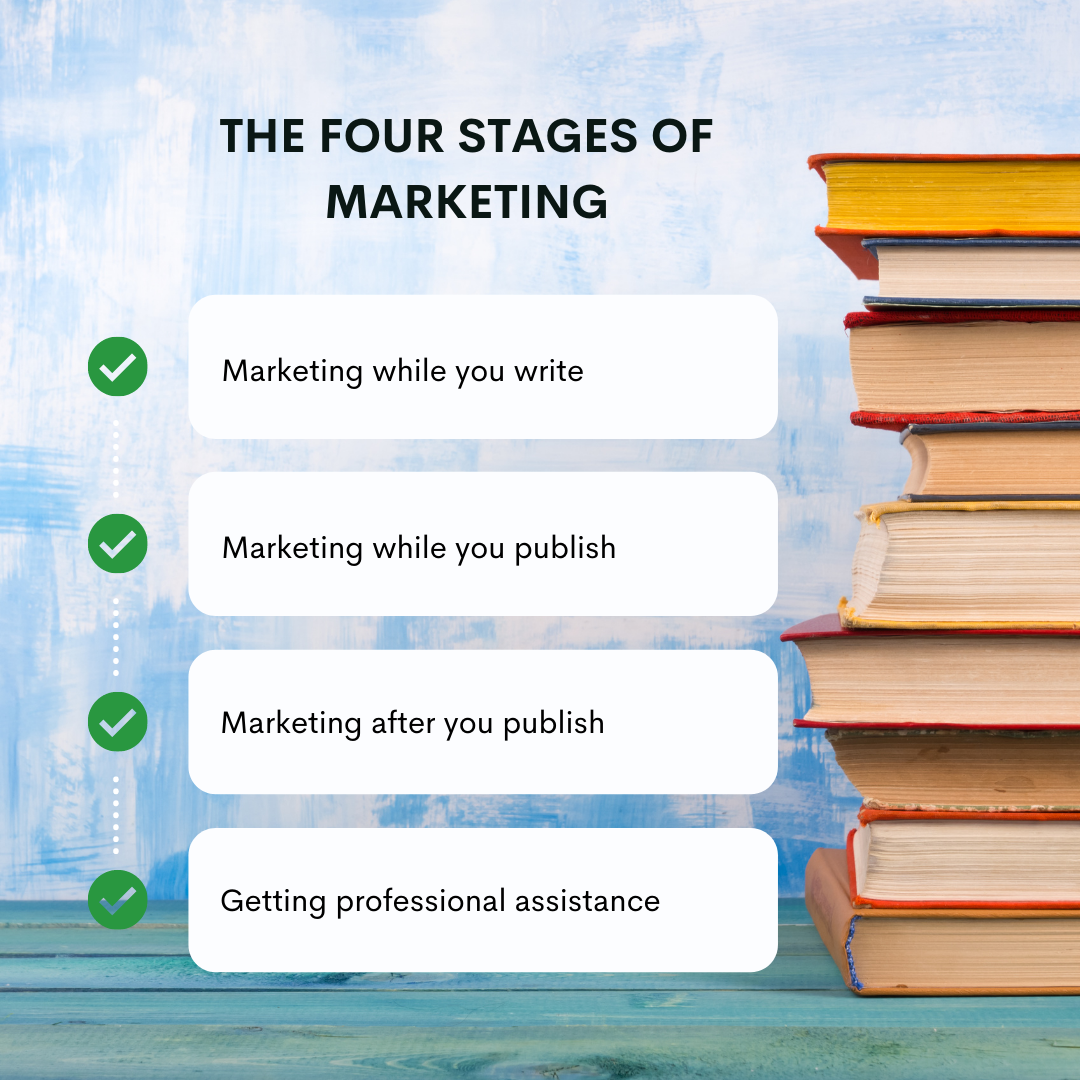Why is marketing your book important?
The beauty of marketing is that you can never be too late or too early. There are so many ways to market or advertise, from before you publish your book to long after. But just because marketing is flexible, that doesn’t mean it’s not important. Marketing is what drives potential readers to find your work, and often is what gets your stories off the (physical or digital) bookstore shelves.
If you are wondering how to start on your marketing journey, check out these great marketing ideas that are definitely worth your time.

Marketing while you write
You might be thinking – if I haven’t even finished my book, why should I start marketing it?
It’s because sparking interest is one of the most important steps towards gaining a reader. Just like with business leads, some people need to see a product several times before they purchase, and it’s the same with books.
There are many reasons why this is the case; here are a few examples:
– People might not understand what you’re advertising
– They could have been busy when they saw the first advertisement and need reminding
– They might be interested, but aren’t in the right financial space to purchase
– People need some more information to trust in your quality
This can even be the case for your loyal friends or family members – and when your audience needs to be swayed, it’s important to stay visible throughout your writing process.
Share your journey on social media
The easiest way to stay visible (for free) is by posting on your social media accounts. You can work with the different social media platforms to create different types of content your audience might want to see – try posting progress images or behind the scenes selfies on your Facebook or Instagram stories, or film a timelapse of an editing process on TikTok. Whatever you do, make sure to stay active and at the forefront of people’s minds.
Get potential reader feedback
Sure, if you’re still writing, you aren’t ready for written reviews. However, you can call out to your existing audience and get their input on key story details – big or small.
If it doesn’t affect the storyline, do an online poll. You could let your followers choose the colour of your main character’s shoes, or let them suggest character names of extras in your novel. While it’s giving away only a small amount of control, people love getting involved, and it might motivate them to see their choices in action once your book gets published.
Join community writing sessions
Nothing compares to authentic advice from people who have gone through similar experiences. By joining a local writing session, this is a great way to network with both starting and successful authors – but it’s also helpful for free advice, a different perspective, or even securing reviewers when your story is ready.
Marketing while you publish
When you finally finish working on your novel, don’t wait until the publishing process is over before you start marketing. Whether you’re self-publishing from start to finish, or getting the help of a publishing house, here are some marketing ideas to keep in mind while you count down the days before your book release.
Contact publishing houses for feedback
Some publishing houses (like us at InHouse Publishing) are more than happy to look over your work, providing you with a free page of feedback. While this may not initially help with public exposure, you can use words from the feedback as a review from an industry professional. This will help to set your book apart from others without agency.
Document your publishing stages online
Like sharing your writing progress on social media, you can also share journeys during the publishing stage. Take some photos of your edited manuscript and make sure everyone knows where you’re at. When you finally receive your printed books, don’t forget to film an unboxing reel for Instagram!
Alert the media of your book release
If you want your book to reach the public without paying for an advertisement, you will need to create a compelling media release. This should include quotes from you (the author) and anyone else involved who is happy to be featured in articles.
To ensure your media release doesn’t get sent to the advertisement team for a quote, you need to base the release more around news-worthy content, rather than details you would advertise. After all, if they use your quotes for a story, they will often put your book details in the article regardless.
Firstly, think about relevance to the media you’re contacting. Are you hosting a book launch at your local library that might be good for their community section? What about the contents of your book – does it write about a specific town that the local council might want to know about? Do you have any public officials joining your book launch that the media want a photo opportunity with?
News outlets are always looking for fresh content, you just need to make sure your media release reads more like a story than an advertisement.
Marketing after you publish
Once you have your book in hand, this is where your marketing ramps up. After all, you want to sell your books. Even for those strictly using an eBook format, these different marketing strategies will help improve your book sales.
Host a book launch (or two, or three!)
Book launches bring a lot of interest to your book, especially to demographics you might not have been able to reach with your other marketing strategies. Like mentioned in the media release section, you can invite whoever you want to your book launch – even public figures and politicians. Encourage your attendees to take photos at these events and share them online, giving you even more free advertisement!
The best part about book launches? You can have as many as you like, ramping up your book sales each time.
Consistent online content
Especially if you’re working in the digital sphere for eBooks, this time is where your social media content will need to ramp up. Creating a content plan is important in the post-publication stages, keeping people interested in your story, and potentially more stories to come in the future. Maintain your online presence with book readings, Q&A sessions and any type of online public involvement you can think of. If you have a website, this also involves creating blogs or sending out relevant emails, allowing you to update the people on your mailing list with anything worth knowing.
Advertising in person
While online marketing is a focus post COVID, it’s often worthwhile exploring your options in person, too. We suggest approaching independent bookstores with information about your book, including its retail price and a wholesale discount you’re prepared to offer them. This might get your book into their physical bookstore, which can heavily benefit book sales.
To appear professional, there are different print items including business cards, pamphlets and even bookmarks you can bring along to help gain the interest of whoever you are talking to.
When you’ve finished meeting people in person, make sure to get their contact details and follow up on the meeting via phone call or email throughout the next week.
How we can help with marketing your book
These different marketing strategies will help boost your readership, but a good result can be at a cost of extensive time and effort. If you would prefer to leave your book marketing to the professionals, our team is more than happy to help.
We have different packages that include media release creation, social media planning, professionally designed documents to advertise your books to independent bookstores, and event book launch assistance.
Get in contact with a publishing consultant today via email: publishing@inhouseprint.com.au or book a consultation call on our website.








